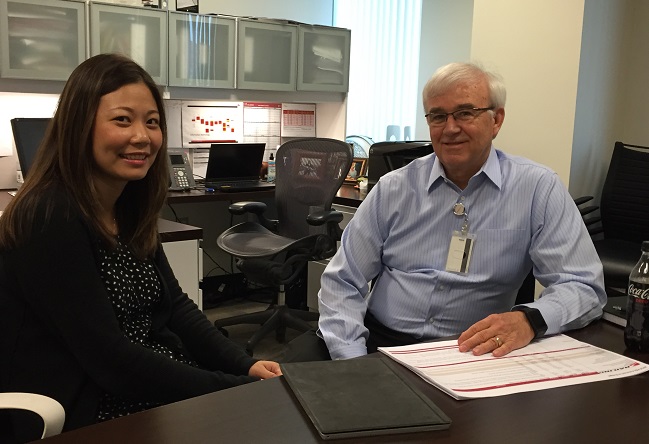
The Triangle Business Journal has named Railinc CIO Jerry Traynham one of the winners of its 2016 CIO Awards. Traynham manages Railinc’s complex technology environment, providing vision and leadership for the company’s data, product development and information systems platforms. He joined Railinc in 2005 and has led a number of significant technology projects, including the technical reengineering of the Umler® system, a foundational application for the North American freight rail industry. A graduate of Clemson University, Traynham has worked nearly 40 years in technology. He has held leadership and management positions with Lucent Technologies, AT&T, Bell Labs and Blue Shoe Technologies, where he led development efforts on applications for the Department of Defense, the Central Intelligence Agency and others. He talks about his career, technology and Railinc below.
 |
| Railinc CIO Jerry Traynham, right, with Joan Smemoe, director of application engineering |
How did you get into technology and software?
I had a strong affinity for mathematics and engineering in high school. My dad was an engineering supervisor, and we had a machine shop on our property. As a kid, I was doing a lot of mechanical design, building go-karts. When I went to college, there wasn’t a computer science curriculum, so I pursued an electrical engineering degree, which encompassed computer science. After graduation, I went to work at Bell Labs as a systems engineer of radars for the Department of Defense.
The systems engineers designed and integrated the hardware, but we also worked with the software teams. I was drawn to the software side and transferred to a business unit where they were developing the UNIX system and software apps for the telephone industry. I worked shoulder to shoulder with some of the first UNIX developers and rose to project manager for the Trunks Integrated Record Keeping System (TIRKS), a telecom operations support system that’s still in use today. Creating this highly complex, critical industry system was when I really became focused on software engineering.
What do you like about working in technology and at Railinc?
I’ve always liked creating products that provide value and solve important problems. That was my attraction to Railinc. Our products touch the entire lifecycle of a train, and we use a lot of leading-edge technologies here, which is exciting for me and our engineers. We have tremendous breadth and depth for a company of about 300 people, particularly from an architecture, technology stack and design perspective.
Being a centralized hub for the North American freight rail industry, we maintain a wide range of apps that includes everything from financial exchanges to apps that help in the design of a railcar. Before I joined the company, I was doing work for the Central Intelligence Agency and the Department of Defense on some interesting, high-tech applications. I’m drawn to building things that add value. If I’m not able to do that, I’m not going to be particularly interested in the work.
What are the biggest technology challenges Railinc faces today?
One of Railinc’s greatest challenges is managing technology refresh. The rate of technology change continues to accelerate, supporting new use cases, and we work hard to stay ahead. One area we’re presently looking at is mobility, where we don’t have much of a presence today. Because of safety, there has been a concern around using mobile devices in railyards. But today, it’s possible to have in the palm of your hand devices that can enable you to perform business processes and analytics wherever you are, and our customers are adapting operational processes to take advantage of these capabilities.
Another area of challenge and opportunity is big data. There’s opportunity for us in both analysis and management of data. We’re a data hub for the industry, and we have enormous feeds of data coming in. The railroads are fielding sensor systems around North America that are capable of sending data to Railinc. I don’t believe many people fully realize the power or the growth of that data yet. The challenge is to continue to provide the technology, tools and expertise to enable that data to better serve the freight rail industry.
How do you approach strategic planning for the IT group?
It’s important for us to understand what the strategic plan is from the business team. We work to make sure that our IT strategy aligns with Railinc’s business strategy. Some strategic areas are more IT-centric and focus on IT workflows and processes. One example is security. It’s a top priority for our Board of Directors, and we have made significant investments in our security program the last two years. It’s the kind of investment that isn’t apparent to our end users, but our strategy is to have a security program in place that keeps all our business processes running and all our data secure and protected. I have quite a bit of experience in cybersecurity during my career and have seen the benefit of having a strong security program and what happens when you don’t.
Another important part of our strategy is staying current in our technology stack while at the same time reducing operational costs. It’s a continual challenge to maintain that balance. We look for open source options where possible. With the rapid advent of new technologies, we’re able to transition from good, expensive, proprietary solutions to good, open source solutions that may be easier to operate and maintain and that help us reduce costs.
What advice would you give to someone starting out in IT today?
I don’t think the size of the company you start at is that important as long as you have the opportunity to develop or enhance software systems. For most IT people today there are going to be the operations, support and maintenance aspects of the assignments. Finding the opportunity to work in product development or in the integration and support of underlying technologies is key because these enable you to grow professionally.
Also, it’s important to work on teams where you can realize mentoring, both in development techniques and quality processes. At Railinc, we are very supportive of our IT staff’s continued learning and professional advancement. We also emphasize mentoring here, especially from technical and software engineering process perspectives. All software engineers, from development to infrastructure, must stay current with technology changes by connecting with your peers and reading and experimenting as much as you can.
Presented in partnership with the North Carolina Technology Association, the Triangle Business Journal’s annual CIO Awards recognize individuals who are changing the Triangle business community through information technology. Click here to see the 2016 class of CIO Awards winners.
—Railinc Corporate Communications
